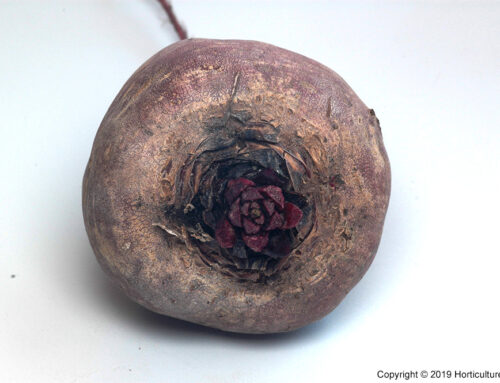
Beetroot harvesting and marketing
Harvesting beetroot
Beetroots is harvested in phases. Initially when the bulbs are 25-40mm in diameter. Size will vary according to variety planted and time of season. This is the first harvest and is merely a thinning out process. The second and final harvest is when the bulbs are 50-75mm in diameter. Days to harvest is 2 1/2 – 3 months in summer and 3 1/2 – 4 months in winter.
Small scale farmers harvest beetroot by hand. This is a slow process and can be expensive as larger fields have to be harvested. Once the beets are harvested they are bunched together with string or rubber bands. Depending on market requirements, 6-8 beets are put together. In most cases beets are washed in a 5% chlorine solution and then washed again. This prolongs shelf life by killing all bacteria that cause postharvest decay. Mechanical harvesters remove the leaves automatically. These beets are not bunched together but are placed in bags or if used for processing they are placed in crates for easy transport.
Processing beetroot
The quality of beetroots used for processing is measured on the colour and fibre content. Dark blood red beets are preferred to light or purple coloured beetroot varieties. Purple flesh varieties tend to discolour or bleach when tinned.
The red colour in beetroot is caused by the concentration of anthocyanin. Colour intensity is a trait of a variety and can be influenced by local climate. For instance, beetroot harvested in winter usually has better colour than harvested in summer. The longer a beetroot is left in the field, the darker the colour becomes.
Young fast growing beetroot is tender and with little fibre. It has an attractive appearance and is soft after boiling. Small 20-60mm bulbs are preferred for canning. The bigger 70-100mm bulbs are used for dicing and slicing. Beetroot that is left on the field for too long has inferior quality for processing because of high fibre content and hardness after boiling.
The shape of the bulb is also very important for processors. Canners have to reduce off-cuts since they purchase the beetroot harvest based on weight. Beetroot must be round ball shaped. Those varieties than tend to have elongated roots are unsuitable. A large leaf crown is also not suitable as it must be cut away and cannot be used.
Physiological disorders such as cracking are often a sign of micro-element deficiencies. Although it is corrected by applying micro-element fertilizers, these beetroots are discarded by the canners.
The best quality beetroot is obtained when growing conditions allow the plant to grow fast, without stress (often caused by climatic conditions such as heat waves or long periods of rain). Most processors prefer Detroit Dark Red.
Beetroot yields
Yield depends on many factors. Expect 18-25t/ha without leaves. 30-40t/ha including leaves. These are average yields but as experience accumulates some growers can achieve higher yields.
Climate has a significant influence on yields. If you don’t have the right climate, yields will not increase by just adding fertilizer. Quite often the quality of the beetroot will decrease and susceptibility to disease will increase. At the end lower profits will be obtained because a smaller marketable yields is obtained at higher cost.





